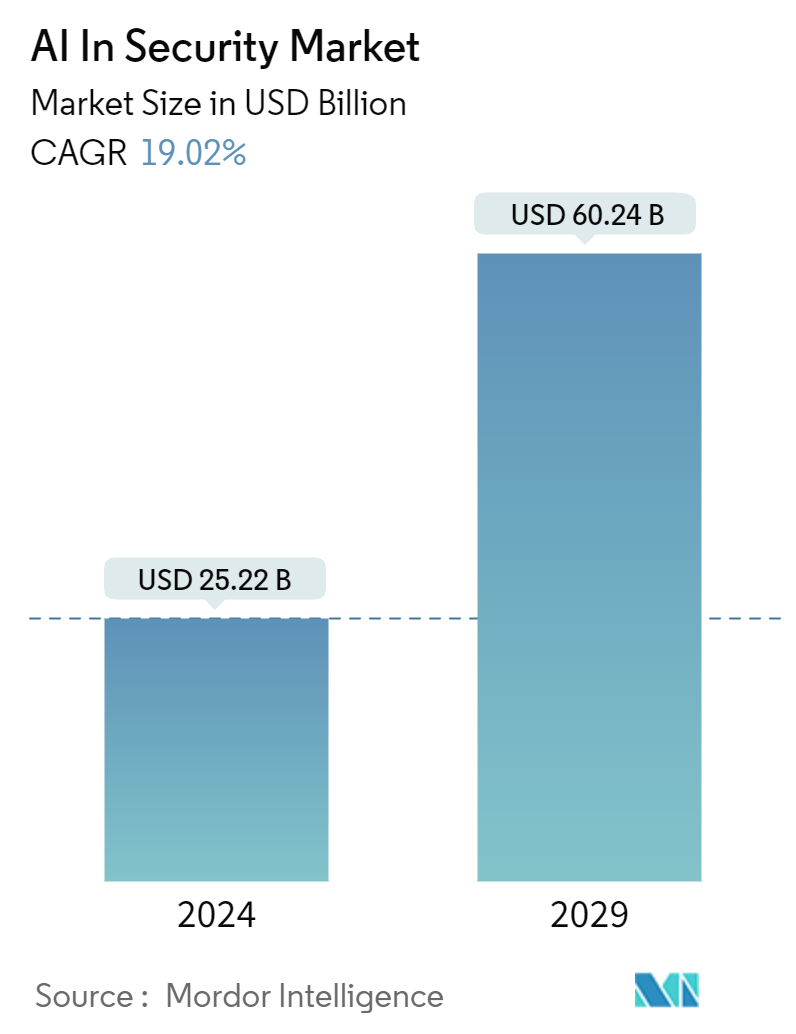Market Size of AI In Security Industry

| Study Period | 2019 - 2029 |
| Market Size (2024) | USD 25.22 Billion |
| Market Size (2029) | USD 60.24 Billion |
| CAGR (2024 - 2029) | 19.02 % |
| Fastest Growing Market | Asia Pacific |
| Largest Market | North America |
Major Players
*Disclaimer: Major Players sorted in no particular order |
AI In Security Market Analysis
The AI In Security Market size is estimated at USD 25.22 billion in 2024, and is expected to reach USD 60.24 billion by 2029, growing at a CAGR of 19.02% during the forecast period (2024-2029).
Artificial intelligence plays a crucial role in the security market by enhancing threat detection, automating responses to cyberattacks, analyzing vast amounts of data for anomalies, and improving overall cybersecurity posture. AI-powered systems can identify patterns indicative of malicious activities, adapt to evolving threats, and provide real-time insights to security professionals, helping them stay ahead of potential breaches.
- With the rise in connected enterprises, devices, and applications, businesses are becoming more vulnerable as they are connected to a mass of independent endpoints. Therefore, AI in security provides an enticing proposition with its proactive threat mitigation capabilities, which are needed for constant supervision and adaptation to the multifaceted security vulnerabilities faced by the modern digitalized economy.
- Atos and Ooredoo partnered to provide key cybersecurity threat detection and response services to Qatar Smart Program "TASMU," which is a smart city program in the country driven by the Ministry of Transport and Communication (MOTC). It also supports Qatar National Vision 2030. Atos and Ooredoo's solution integrates cloud-native, intelligent security analytics and AI capability from the Atos Alsaac platform to secure TASMU's infrastructure and applications.
- The number of cyberattacks is steadily increasing on a global scale. Cybercriminals attack endpoints, networks, data, and other IT resources. Infrastructure is costly for citizens, companies, and governments. Cybercriminals' primary motivations are political rivalry, monetary gain, reputational harm, global competitiveness, and the interest of radical religious organizations. The majority of cyberattacks try to make money. WannaCry, Petya, NotPetya, and BadRabbit are significant ransomware that have severely harmed businesses and government organizations.
- Implementing machine learning with AI enables threats and malware to be proactively prevented rather than only detected. This is expected to help create a vast market opportunity for artificial intelligence in the security market during the forecast period.
- About 97% of Indian organizations have begun investing in AI/ML, while 84% are investing in infrastructure around cloud technology, according to the Data Security Council of India. The intersection of AI with cybersecurity is poised to drive a significant increase in investments in the sector. Also, the nation expects a few investment opportunities in AI and cyber security governance areas. Dallas Venture Capital (DVC) claimed that AI technologies, such as machine learning (ML) and behavioral analytics, are game changers in cybersecurity.
- The rising frequency and sophistication of cyber threats have made traditional security measures insufficient. AI offers advanced capabilities to detect and respond to evolving threats in real time. For instance, South Korea's ICT ministry spent KRW 670 billion (USD 607 million) in 2023 to bolster the country's cybersecurity capabilities to respond to growing new digital threats. The government plans to develop infrastructure to quickly respond to cybersecurity threats by collaborating with central cloud and data center companies to collect threat information in real time, compared to the current system that relies on individual reports.
- The need for more skilled AI professionals and the lack of awareness are expected to restrain the market during the forecast period. According to a report by IBM Security, artificial intelligence (AI), when fully deployed, provided the most significant cost mitigation, up to USD 3.05 million less, at organizations with AI than organizations without AI. The average cost of a data breach increased by 2.6% from USD 4.24 million in 2021 to USD 4.35 million in 2022.
- The Russia-Ukraine war significantly impacted the AI security market. Increased tensions led to heightened cybersecurity concerns, prompting governments and businesses to invest more in AI-driven security solutions to protect against cyber threats, including espionage and hacking attacks. Additionally, geopolitical instability could disrupt supply chains for AI hardware and software components, affecting the availability and pricing of AI security products.
AI In Security Industry Segmentation
AI for security solutions involves integrating endpoint data and analytics to gain threat intelligence, which aids in detecting and exposing an attack in a particular environment. With the growth in online transactions and a surge in NEFT, RTGS, and mobile commerce, the demand for security solutions is increasing. The banking sector noticed a significant rise in adopting artificial intelligence-based security solutions, which helped improve banking services.
The market is segmented by security type (network security, application security, and cloud security), service (professional and managed), deployment (on-premises and cloud), end-user industry (government and defense, retail, BFSI, manufacturing, healthcare, automotive and transportation, and other end-user industries), and geography (North America, Europe, Asia-Pacific, and Rest of the World). The market sizes and forecasts are provided in terms of value (USD) for all the above segments.
| By Security Type | |
| Network Security | |
| Application Security | |
| Cloud Security |
| By Service | |
| Professional Services | |
| Managed Services |
| By Deployment | |
| On-premise | |
| Cloud |
| By End-user Industry | |
| Government & Defense | |
| Retail | |
| BFSI | |
| Manufacturing | |
| Healthcare | |
| Automotive & Transportation | |
| Other End-user Industries |
| By Geography | ||||||||
| ||||||||
| ||||||||
| ||||||||
|
AI In Security Market Size Summary
The artificial intelligence in security market is experiencing significant growth, driven by the increasing need for advanced threat detection and response capabilities in the face of rising cyber threats. AI technologies are enhancing cybersecurity by automating threat detection, analyzing vast data for anomalies, and providing real-time insights to security professionals. This proactive approach is crucial as businesses become more interconnected, exposing them to a myriad of security vulnerabilities. The market is characterized by a competitive landscape with numerous companies developing innovative AI-driven security solutions. Partnerships, such as those between Atos and Ooredoo, are exemplifying the integration of AI in securing smart city infrastructures, highlighting the broader application of AI in various sectors, including healthcare and finance.
The market's expansion is further supported by the increasing adoption of AI and machine learning technologies across industries, with significant investments being made to bolster cybersecurity frameworks. Regions like Asia-Pacific are witnessing a surge in demand for AI-powered security solutions due to the high frequency of cyberattacks and the rapid digitization of processes. Regulatory initiatives and the development of digital identity verification systems are also contributing to market growth. However, challenges such as the shortage of skilled AI professionals and geopolitical tensions, which can disrupt supply chains, pose potential restraints. Despite these challenges, the market is poised for substantial growth, with major players like IBM and Cisco leading the charge in developing cutting-edge AI security technologies.
AI In Security Market Size - Table of Contents
-
1. MARKET DYNAMICS
-
1.1 Market Overview
-
1.2 Market Drivers
-
1.2.1 Increasing Number of Security Frauds and Technology Penetration
-
1.2.2 Increasing Number of Malware Attacks (Ransomware) Across Cloud Computing Ecosystem
-
-
1.3 Market Restraints
-
1.3.1 Lack of Skilled AI Professionals
-
-
1.4 Industry Value Chain Analysis
-
1.5 Industry Attractiveness - Porter's Five Force Analysis
-
1.5.1 Threat of New Entrants
-
1.5.2 Bargaining Power of Buyers
-
1.5.3 Bargaining Power of Suppliers
-
1.5.4 Threat of Substitute Products
-
1.5.5 Intensity of Competitive Rivalry
-
-
1.6 Impact of Key Macroeconomic Trends on the Market
-
-
2. MARKET SEGMENTATION
-
2.1 By Security Type
-
2.1.1 Network Security
-
2.1.2 Application Security
-
2.1.3 Cloud Security
-
-
2.2 By Service
-
2.2.1 Professional Services
-
2.2.2 Managed Services
-
-
2.3 By Deployment
-
2.3.1 On-premise
-
2.3.2 Cloud
-
-
2.4 By End-user Industry
-
2.4.1 Government & Defense
-
2.4.2 Retail
-
2.4.3 BFSI
-
2.4.4 Manufacturing
-
2.4.5 Healthcare
-
2.4.6 Automotive & Transportation
-
2.4.7 Other End-user Industries
-
-
2.5 By Geography
-
2.5.1 North America
-
2.5.1.1 United States
-
2.5.1.2 Canada
-
-
2.5.2 Europe
-
2.5.2.1 United Kingdom
-
2.5.2.2 Germany
-
2.5.2.3 France
-
2.5.2.4 Italy
-
2.5.2.5 Spain
-
2.5.2.6 Rest of Europe
-
-
2.5.3 Asia-Pacific
-
2.5.3.1 China
-
2.5.3.2 Japan
-
2.5.3.3 India
-
2.5.3.4 South Korea
-
2.5.3.5 Rest of Asia-Pacific
-
-
2.5.4 Rest of the World
-
2.5.4.1 Latin America
-
2.5.4.2 Middle East and Africa
-
-
-
AI In Security Market Size FAQs
How big is the AI In Security Market?
The AI In Security Market size is expected to reach USD 25.22 billion in 2024 and grow at a CAGR of 19.02% to reach USD 60.24 billion by 2029.
What is the current AI In Security Market size?
In 2024, the AI In Security Market size is expected to reach USD 25.22 billion.

